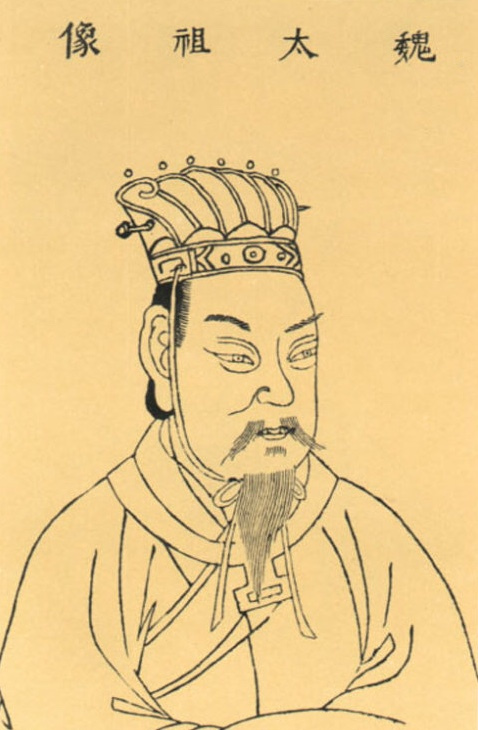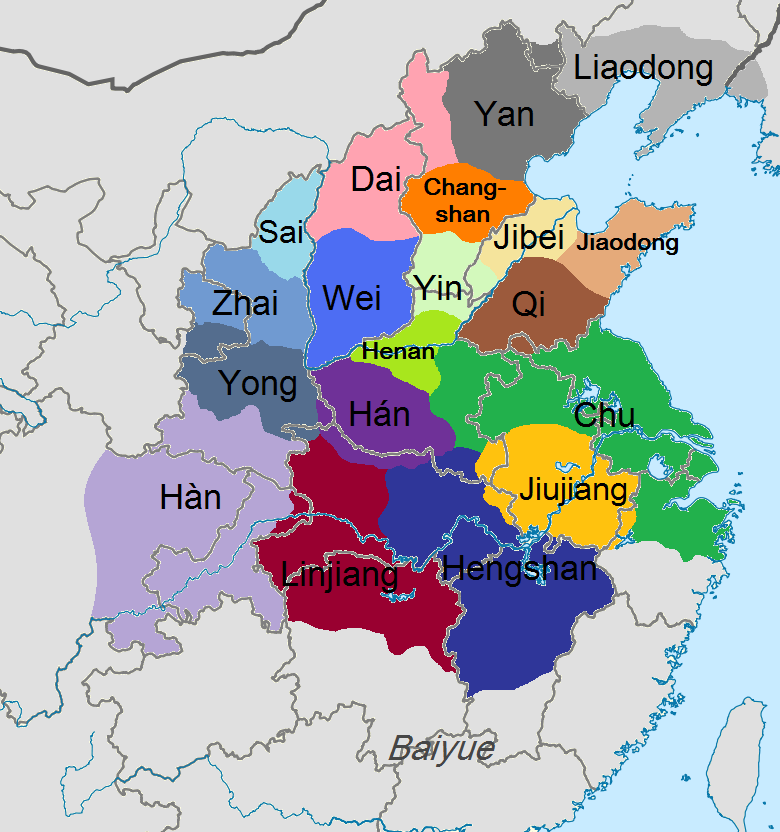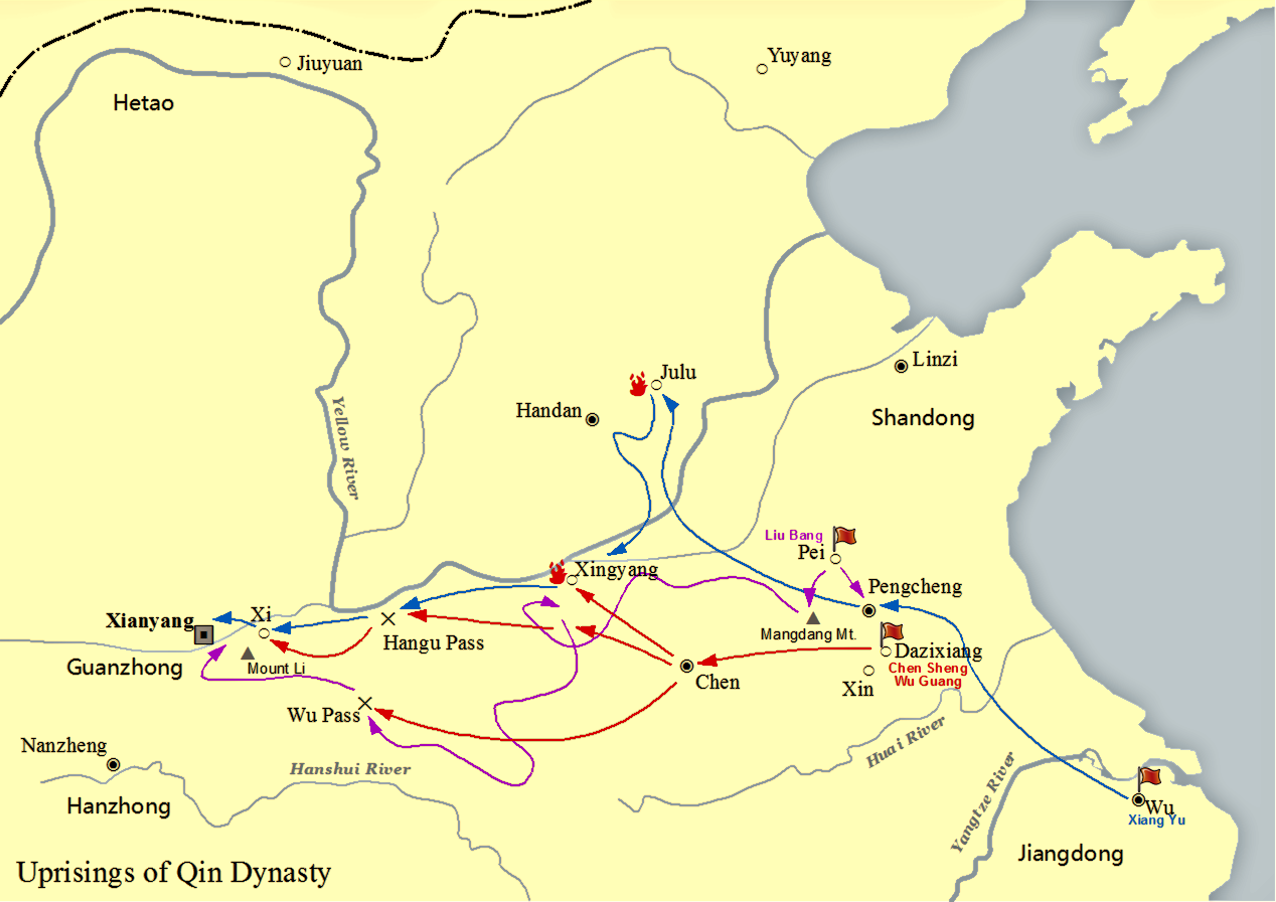|
Changsha Kingdom
The Changsha Kingdom was a kingdom within the Han Empire of China, located in present-day Hunan and some surrounding areas. The kingdom was founded when Emperor Gaozu granted the territory to his follower Wu Rui in 203 or 202 BC, around the same time as the establishment of the Han dynasty. Wu Rui and his descendants held the kingdom for five generations until Wu Zhu died without an heir in 157 BC. In 155 BC, the kingdom was reestablished for a member of the imperial family. However, the creation of this second kingdom coincided with the Rebellion of the Seven States and the subsequent reforms under Emperor Jing, and Changsha under the imperial family saw its autonomy greatly diminished. The kingdom was dissolved during Wang Mang's usurpation (AD 9 – 23), briefly restored after the founding of the Eastern Han, and finally abolished in and converted to a commandery under the imperial government. Changsha was one of the largest and longest-lasting kingdoms in Han China. D ... [...More Info...] [...Related Items...] OR: [Wikipedia] [Google] [Baidu] |
Chancellor (China)
The grand chancellor (, among other titles), also translated as counselor-in-chief, chancellor, chief councillor, chief minister, imperial chancellor, lieutenant chancellor and prime minister, was the highest-ranking executive official in the imperial Chinese government. The term was known by many different names throughout Chinese history, and the exact extent of the powers associated with the position fluctuated greatly, even during a particular dynasty. Professor Zhu Zongbin of Peking University outlined the role of "grand chancellor" as one with the power to oversee all jurisdictional matters, the right to decide and to draft edicts with other ministers, and the position of chief advisor to the emperor. This extended even to the ability to criticize the emperor's edicts and decisions. Thus, the grand chancellor served as the emperor's chief of staff and main political advisor, often exercising power second only to the emperor. In practice, the grand chancellor was often a ... [...More Info...] [...Related Items...] OR: [Wikipedia] [Google] [Baidu] |
Buffer State
A buffer state is a country geographically lying between two rival or potentially hostile great powers. Its existence can sometimes be thought to prevent conflict between them. A buffer state is sometimes a mutually agreed upon area lying between two greater powers, which is demilitarised in the sense of not hosting the armed forces of either power (though it will usually have its own military forces). The invasion of a buffer state by one of the powers surrounding it will often result in war between the powers. Buffer states, when authentically independent, typically pursue a neutralist foreign policy, which distinguishes them from satellite states. The concept of buffer states is part of a theory of the balance of power that entered European strategic and diplomatic thinking in the 18th century. After the First World War, notable examples of buffer states were Poland and Czechoslovakia, situated between major powers such as Germany and the Soviet Union. Lebanon is another si ... [...More Info...] [...Related Items...] OR: [Wikipedia] [Google] [Baidu] |
Chu–Han Contention
The Chu–Han Contention (), also known as the Chu–Han War (), was an interregnum in Imperial China between the fall of the Qin dynasty and the establishment of the Han dynasty. After the Qin dynasty was overthrown in 206 BCE, the empire was divided into the Eighteen Kingdoms ruled by enfeoffed rebel leaders and surrendered Qin generals according to arrangement by Xiang Yu, the hegemon warlord. Due to dissatisfaction among the rebels, a civil war soon broke out, most prominently between two major powersXiang Yu and Liu Bang, who were the rulers of the Western Chu and Han kingdoms, respectively. Other contending kingdoms also waged war against Chu and Han and among themselves, but these were largely insignificant compared to the Chu-Han conflict. The war ended with a total victory to Han at the Battle of Gaixia in 202 BCE, during which Xiang Yu committed suicide after losing all his men in a last stand. Liu subsequently proclaimed himself emperor of the newly ... [...More Info...] [...Related Items...] OR: [Wikipedia] [Google] [Baidu] |
Eighteen Kingdoms
The historiographical term "Eighteen Kingdoms" ( zh, t=十八國), also translated as "Eighteen States", refers to the eighteen '' fengjian'' states in China created by military leader Xiang Yu in 206 BCE, after the collapse of the Qin dynasty.林达礼,中华五千年大事记, 台南大孚书局, 1982, p. 56 The establishment and abolishment of the Eighteen Kingdoms marked the beginning and end of a turbulent interregnum known as the Chu–Han Contention. The details of the feudal division are as follows: The Eighteen Kingdoms were short-lived. Almost immediately rebellion broke out in Qi, after which Tian Rong conquered Jiaodong and Jibei, reuniting the old Qi state. Meanwhile, Xiang Yu had Emperor Yi of Chu and King Han Cheng of Hán killed. Thereafter, Liu Bang of Hàn conquered the lands of the Three Qins, thereby formally starting the Chu–Han Contention. Following many battles and changing alliances, Han defeated Chu and subdued all other kingdoms, where Liu Ba ... [...More Info...] [...Related Items...] OR: [Wikipedia] [Google] [Baidu] |
Xiang Yu
Xiang Yu (), born Xiang Ji, was a Chinese warlord who founded and led the short-lived ancient Chinese states, kingdom-state of Western Chu during the interregnum period between the Qin dynasty, Qin and Han dynasty, Han dynasties of China, dynasties known as the Chu–Han Contention (206–202 BC). A nobleman of the former state of Chu, Xiang Yu rebelled against the Qin dynasty under the command of his uncle Xiang Liang, and was granted the title of "Duke of Lu" () by Emperor Yi of Chu, King Huai II of the restoring Chu state in 208 BC. The following year, he led an outnumbered Chu army to victory at the Battle of Julu against the Qin armies led by Zhang Han (Qin dynasty), Zhang Han. After the fall of Qin, Xiang Yu divided the country into a federacy of Eighteen Kingdoms, among which he was self-titled as the "Hegemon-King of Western Chu" () and ruled a vast region spanning central and eastern China, with Pengcheng as his capital. Although a formidable warrior and milita ... [...More Info...] [...Related Items...] OR: [Wikipedia] [Google] [Baidu] |
Western Chu
Chu (, Old Chinese: ''*s-r̥aʔ'') was an ancient Chinese state during the Zhou dynasty. Their first ruler was King Wu of Chu in the early 8th century BC. Chu was located in the south of the Zhou heartland and lasted during the Spring and Autumn period. At the end of the Warring States period it was annexed by the Qin in 223 BC during the Qin's wars of unification. Also known as Jing () and Jingchu (), Chu included most of the present-day provinces of Hubei and Hunan, along with parts of Chongqing, Guizhou, Henan, Anhui, Jiangxi, Jiangsu, Zhejiang, and Shanghai. For more than 400 years, the Chu capital Danyang was located at the junction of the Dan and Xi Rivers near present-day Xichuan County, Henan, but later moved to Ying. The house of Chu originally bore the ancestral temple surname Nai ( OC: /*rneːlʔ/) which was later written as Mi ( OC: /*meʔ/). They also bore the lineage name Yan ( OC: /*qlamʔ/, /*qʰɯːm/) which would later be written Xiong ( OC ... [...More Info...] [...Related Items...] OR: [Wikipedia] [Google] [Baidu] |
Ziying Of Qin
Ying Ziying, also known as Ziying, King of Qin (, died January 206 BC), was the third and last ruler of the Qin dynasty of China. He ruled over a fragmented Qin Empire for 46 days, from mid-October to early December 207 BC. Unlike his predecessor, he ruled as a king instead of emperor. He is referred to in some sources with the posthumous name Emperor Shang of Qin () although the Qin dynasty had abolished the tradition of according posthumous names to deceased monarchs. Identity There is no firm consensus as to what Ziying's relationship to the Qin royal family really was. He is mentioned in historical records as either: #A son of Qin Er Shi's elder brother (who, according to Yan Shigu's commentaries, was Fusu); #An elder brother of Qin Er Shi; #A younger brother of Qin Shi Huang; or #A son of a younger brother of Qin Shi Huang. While Sima Qian's ''Records of the Grand Historian'' does not specify Ziying's age, it implies that he had at least two sons, who ... [...More Info...] [...Related Items...] OR: [Wikipedia] [Google] [Baidu] |
Guanzhong Plain
Guanzhong (, formerly romanization of Chinese, romanised as Kwanchung) region, also known as the Guanzhong Basin, Wei River Basin, or uncommonly as the Shaanzhong region, is a historical region of China corresponding to the crescentic graben structural basin, basin within present-day central Shaanxi, bounded between the Qinling Mountains in the south (known as Guanzhong's "South Mountains"), and the Huanglong Mountain, Meridian Ridge and Mount Liupan, Long Mountain ranges in the north (collectively known as its "North Mountains"). The central plain, flatland area of the basin, known as the Guanzhong Plain (关中平原; pinyin: Guānzhōng Píngyuán), is made up of alluvial plains along the lower Wei River and its numerous tributaries and thus also called the Wei River Plain. The region is part of the Shanxi, Jin-Shaanxi, Shaan Basin Belt, a prominent section of the Shanxi Rift System, and is separated from its geological sibling — the Yuncheng Basin to its northeast — by the ... [...More Info...] [...Related Items...] OR: [Wikipedia] [Google] [Baidu] |
Liu Bang
Emperor Gaozu of Han (2561 June 195 BC), also known by his given name Liu Bang, was the founder and first emperor of the Han dynasty, reigning from 202 to 195 BC. He is considered by traditional Chinese historiography to be one of the greatest emperors in history, credited with establishing the first Pax Sinica, one of China's longest golden ages. Liu Bang was among the few dynastic founders to have been born in a peasant family. He initially entered the Qin dynasty bureaucracy as a minor law enforcement officer in his home town in Pei County, within the conquered state of Chu. During the political chaos following the death of Qin Shi Huang, who had been the first emperor in Chinese history, Liu Bang renounced his civil service position and became a rebel leader, taking up arms against the Qin dynasty. He outmanoeuvred rival rebel leader Xiang Yu to invade the Qin heartland and forced the surrender of the Qin ruler Ziying in 206 BC. After the fall of ... [...More Info...] [...Related Items...] OR: [Wikipedia] [Google] [Baidu] |
Collapse Of Qin
The Qin dynasty ( ) was the first imperial dynasty of China. It is named for its progenitor state of Qin, a fief of the confederal Zhou dynasty (256 BC). Beginning in 230 BC, the Qin under King Ying Zheng engaged in a series of wars conquering each of the rival states that had previously pledged fealty to the Zhou. This culminated in 221 BC with the successful unification of China under Qin, which then assumed an imperial prerogativewith Ying Zheng declaring himself to be Qin Shi Huang, the first emperor of China, and bringing an end to the Warring States period (221 BC). This state of affairs lasted until 206 BC, when the dynasty collapsed in the years following Qin Shi Huang's death. The Qin dynasty's 14-year existence was the shortest of any major dynasty in Chinese history, with only two emperors. However, the succeeding Han dynasty (202 BC220 AD) largely continued the military and administrative practices instituted by the Qin; as a ... [...More Info...] [...Related Items...] OR: [Wikipedia] [Google] [Baidu] |
Dazexiang Uprising
The Chen Sheng and Wu Guang uprising (), August 209 B.C.– January 208 B.C., was the first uprising against the Qin dynasty following the death of Qin Shi Huang. Led by Chen Sheng and Wu Guang, the uprising was unsuccessful. Name It is also called the Dazexiang uprising () as the uprising started in Dazexiang (大泽乡), which translates into "Big Swamp Village". History Chen Sheng and Wu Guang were both army officers who were ordered to lead their bands of commoner soldiers north to participate in the defense of Yuyang ( zh, s=渔阳, t=漁陽). However, they were stopped halfway in present-day Anhui province by flooding from a severe rainstorm. The harsh Qin laws mandated execution for those who showed up late for government jobs, regardless of the nature of the delay. Figuring that they would rather fight than accept execution, Chen and Wu organized a band of 900 villagers to rebel against the government. The current emperor, Huhai, had killed his brother Fusu, who ... [...More Info...] [...Related Items...] OR: [Wikipedia] [Google] [Baidu] |





